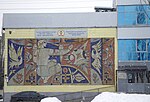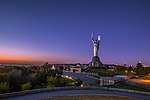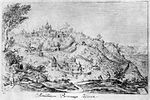Paton Bridge
1953 establishments in UkraineBridges built in the Soviet UnionBridges completed in 1953Bridges over the DnieperEuropean route E95 ... and 1 more
Road bridges in Kyiv

Paton Bridge is one of the bridges across the Dnieper in Kyiv, Ukraine named after its constructor Evgeny Paton. Built between 1941 and 1953, it is one of the world's first all-welded bridge and is also the longest bridge in Kyiv having a length of 1,543 metres (5,062 ft). Traffic across the bridge was opened on 5 November 1953. The bridge also acts as a segment of the Lesser Ring Road of Kyiv.
Excerpt from the Wikipedia article Paton Bridge (License: CC BY-SA 3.0, Authors, Images).Paton Bridge
Mykoly Mikhnovskoho Boulevard, Kyiv Vydubychi
Geographical coordinates (GPS) Address External links Nearby Places Show on map
Geographical coordinates (GPS)
| Latitude | Longitude |
|---|---|
| N 50.427222222222 ° | E 30.581944444444 ° |
Address
міст Патона
Mykoly Mikhnovskoho Boulevard
01000 Kyiv, Vydubychi
Ukraine
Open on Google Maps










